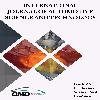Mixer with Secondary Venturi: An Invention for the First-Generation LPG Kits
Engine torque and power are one of the problems in LPG applications for vehicles with first-generation converter kits. Therefore, this paper presents the results of the development of a mixer prototype to be applied to LPG fueled vehicles with first-generation converter kits (converters and mixers). A series of work is done beginning from design, prototyping, and ending by testing of prototypes to vehicles. The prototyping process includes design activities and machining activities. Design activities are carried out with Pro-Eng software and machining activities are carried out with a turning machine. Furthermore, the prototype mixer was tested on a 1500 cc engine. Output torque and power are measured on a chassis dynamometer with the standardized test method. The results of this study indicate that the mixer with secondary venturi shows better output torque and power than a standard mixer at almost all daily speeds for public fleet and private vehicles. In conclusion, mixer with secondary venturi is feasible to implement, especially for public transport with heavy loads.
Keywords:
LPG fueled vehicle, converter mixer, secondary venturi,
___
- [1] E. Prasodjo et al., Indonesia Energy Outlook 2016. Jakarta: Indonesian National Energy Council, 2016.
- [2] Central Bureau of Statistics Republic of Indonesia, “The Number of Motorized Vehicles by Type, 1949-2016,” 2018. [Online]. Available: https://www.bps.go.id/linkTabelStatis/view/id/1322. [Accessed: 08-Aug-2018].
- [3] M. R. Werpy, A. Burnham, and K. Bertram, “Propane Vehicles : Status, Challenges, and Opportunities,” Argonne, 2010.
- [4] J. Adolf, C. Balzer, A. Joedicke, and U. Schabla, “Shell LPG Study,” Hamburg, 2015.
- [5] ETSAP, “Automotive LPG and Natural Gas Engines,” © IEA ETSAP - Technol. Br. T03, no. April, pp. 1–5, 2010.
- [6] M. A. Ceviz and F. Yüksel, “Cyclic variations on LPG and gasoline-fuelled lean burn SI engine,” Renew. Energy, vol. 31, pp. 1950–1960, 2006.
- [7] M. Gumus, “Effects of volumetric efficiency on the performance and emissions characteristics of a dual fueled (gasoline and LPG) spark ignition engine,” Fuel Process. Technol., vol. 92, no. 10, pp. 1862–1867, 2011.
- [8] A. Sürmen and M. Ihsan, “A comparative study of carburation and injection fuel supply methods in an LPG-fuelled SI engine,” vol. 107, pp. 511–517, 2013.
- [9] B. Erkus, A. Surmen, M. I. Karamangil, R. Arslan, and C. Kaplan, “The effect of ignition timing on performance of LPG injected SI engine,” Energy Educ. Sci. Technol. Part a-Energy Sci. Res., vol. 28, no. 2, pp. 1199–1206, 2012.
- [10] B. Erkuş, M. I. Karamangil, and A. Sürmen, “Enhancing the heavy load performance of a gasoline engine converted for LPG use by modifying the ignition timings,” Appl. Therm. Eng., vol. 85, pp. 188–194, 2015.
- [11] A. Kaleli, M. A. Ceviz, and K. Erenturk, “Controlling spark timing for consecutive cycles to reduce the cyclic variations of SI engines,” Appl. Therm. Eng., vol. 87, pp. 624–632, 2015.
- [12] C. Gong, F. Wei, X. Si, and F. Liu, “Effects of injection timing of methanol and LPG proportion on cold start characteristics of SI methanol engine with LPG enriched port injection under cycle-by-cycle control,” Energy, vol. 144, pp. 54–60, 2018.
- [13] S. M. Lawankar, “Comparative Study of Performance of LPG Fuelled Si Engine at Different Compression Ratio and Ignition Timing,” Int. J. Mech. Eng. Technol., vol. 3, no. 4, pp. 337–343, 2012.
- [14] K. Ravi and E. Porpatham, “Effect of piston geometry on performance and emission characteristics of an LPG fuelled lean burn SI engine at full throttle condition,” Appl. Therm. Eng., vol. 110, pp. 1051–1060, 2017.
- [15] M. A. Ceviz, A. Kaleli, and E. Güner, “Controlling LPG temperature for SI engine applications,” Appl. Therm. Eng., vol. 82, pp. 298–305, 2015.
- [16] C. Çinar, F. Şahin, Ö. Can, and A. Uyumaz, “A comparison of performance and exhaust emissions with different valve lift profiles between gasoline and LPG fuels in a SI engine,” Appl. Therm. Eng., vol. 107, pp. 1261–1268, 2016.
- [17] World LPG Association, “Autogas Incentive Policies,” Neuilly-sur-Seine, 2018.
- [18] World LPG Association, “Autogas Incentive Policies, 2017 Edition,” Neuilly-sur-Seine, 2017.
- [19] V. Susanti, A. Hartanto, A. S. Ridwan, M. S. Hendri, R. Estiko, and A. Hapid, “Fuel Subsidy and Air Pollution Reduction by Policy Program Of Conversion Fuel CNG for Vehicles in West Java Province,” J. Mechatronics, Electr. Power, Veh. Technol., vol. 01, no. 2, pp. 43–52, 2010.
- [20] H. Budya and M. Yasir Arofat, “Providing cleaner energy access in Indonesia through the megaproject of kerosene conversion to LPG,” Energy Policy, vol. 39, no. 12, pp. 7575–7586, Dec. 2011.
- [21] M. Setiyo, B. Waluyo, M. Husni, and D. W. Karmiadji, “Characteristics of 1500 CC LPG fueled engine at various of mixer venturi area applied on Tesla A-100 LPG vaporizer,” J. Teknol., pp. 43–49, 2016.
- Yayın Aralığı: Yılda 4 Sayı
- Başlangıç: 2016
- Yayıncı: Otomotiv Mühendisleri Derneği
